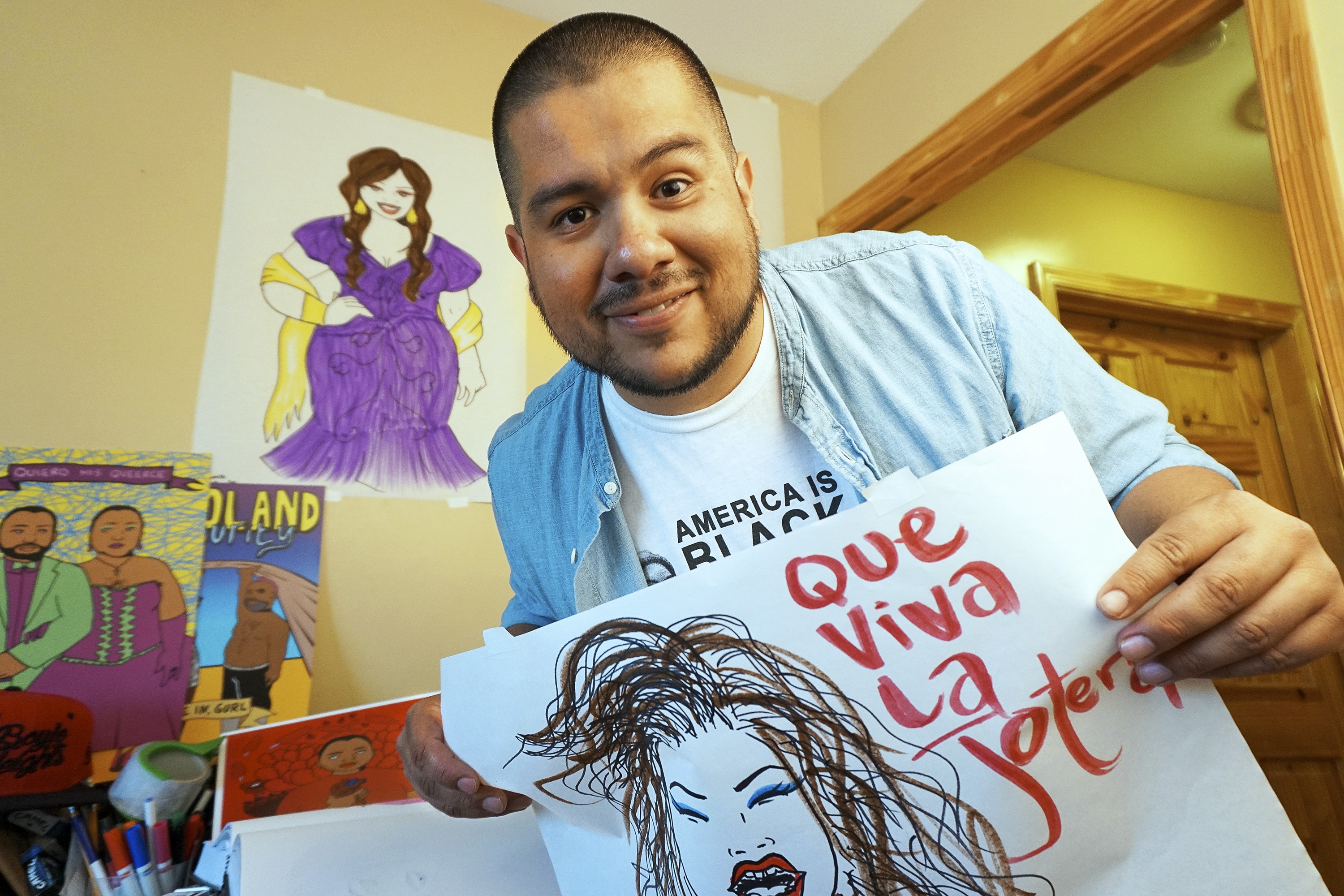
As a youth, Julio Salgado had to come out of the closet twice: First to reveal his sexuality, and second to reveal his undocumented status. Growing up in a Latinx family, he said he found it easier to come out as undocumented to some of his friends than it was to come out as gay to his parents.
A few years ago, the term UndocuQueer was unheard of. But today, it’s given people such as Salgado — a queer artist who is also a Dreamer (an undocumented youth protected under President Obama’s DACA program) — a powerful voice.
His visual art, in the form of illustrations, comics, and videos, reflects the intersectionality of being undocumented and queer and gives insight into what it’s like trying to survive this duality and how he’s able to keep going. His illustrations depict queer people of color in bright neon colors, using politically charged phrases such as “Out of the Closet! Out of the Shadows! Onto the Street!” One of his most powerful illustrations is a self-portrait in which a shirtless Salgado, depicted as a butterfly, has the message “I Exist. Yo Existo” written across his chest and phrases “migrant queerness,” “amor, familia, unidad, paz” inside his wings.
Through his illustrations, Salgado wants to bring awareness to the complex issue of immigration and being queer, but also to leave behind his legacy in case he is deported. “I want to create a world that can’t be destroyed if something happens to me,” said Salgado, who splits his time between Berkeley and Los Angeles.
Salgado was born in Ensenada, Mexico. In 1995, he and his parents and his sister, who was suffering from a life-threatening medical condition, immigrated to the United States. Due to the severity of his sister’s health, his family decided to overstay their visas and live undocumented.
They settled in Long Beach, where Salgado hid his queerness while also dealing with being undocumented. In eighth grade, he began drawing as a way to privately explore and express his sexuality. He attended Cal State Long Beach, where he served as cartoonist for the student newspaper and studied journalism — without financial aid, which was not available to undocumented students at the time. In 2010, he obtained his bachelor’s degree.
That same year, Salgado saw an image that changed his life. A group of Dreamers protested in front of the Hart Senate Office Building in Washington, D.C. One of those Dreamers, Diana Yael Martinez, got arrested after refusing to leave the building. The sit-in received national media attention and a photograph of Martinez ended up in the Washington Post. Salgado, who had been following the protests, came across the image. Seeing the Dreamers risk deportation while fighting for their right to obtain legal status inspired him to become part of the fight.
He drew an illustration of Martinez based on the photo. The illustration, and his subsequent artwork, became powerful imagery used by Dream Act activists across the nation.
[pullquote-1]
Several UndocuQueer Dreamers were front and center of the fight to pass the Dream Act. While they weren’t successful, their activism and acts of civil disobedience played a crucial role in President Obama’s decision to issue the controversial executive action known as DACA, which granted more than 800,000 youth relief from deportation. Salgado was one of them.
While living in Long Beach, Salgado developed an interest in the Bay Area thanks to Latinx queer artist Favianna Rodriguez. Her art and political activism on immigration inspired Salgado to meet the Oakland native. “I sent her a message, and she didn’t respond,” Salgado recalled. “It wasn’t until another friend introduced us that I was finally able to meet her.”
That meeting ultimately influenced Salgado’s decision to move to the Bay Area. Rodriguez took him under her wing as a friend and mentor.
Salgado settled in Berkeley and joined Culture Strike, a nationwide network of artists and political activists who support the local, national, and global arts movement around immigration. The Oakland organization was co-founded by Rodriquez, who also serves as executive director. “Culture Strike wants to change the anti-immigrant narrative,” Salgado said.
In 2012, he got involved in an art project with the Undocumented Queer Youth Collective and the Queer Undocumented Immigrant Project (QUIP) called “I am UndocuQueer!” As part of the project, Salgado created illustrations based on photos and stories submitted by the UndocuQueer community. His comic-style art helped narrate the stories of these individuals often living in the shadows.
Salgado uses his craft to create a safe space for his community. After the Pulse Nightclub shooting in 2016, he started a series called “Queer and Trans People of Color Club Takeover.” He drew illustrations based on photos he took of queer folks at different events. The pieces became part of an exhibit called Que Siga La Fiesta: A Celebration of Queer and Trans Resilience in Times of Crisis.
Salgado knows firsthand the fear inflicted by anti-immigrant rhetoric. After Donald Trump got elected, immigration checkpoints began popping up around Los Angeles. Salgado’s parents, who are still undocumented, live in Compton, and these checkpoints present an imminent danger for them. If detained, they risk deportation. Salgado knew that he needed to be close to his family in case of an emergency.
“I don’t want to give Trump the power to decide my happiness,” Salgado said. (Although now there are rumors that Trump is threatening to end the DACA program.)
Salgado acknowledged that some people find comfort in doing things they love and prefer not to get involved in protests. But he said everyone should engage in political activism in whatever way they feel necessary.
“Art should be about joy,” he said.











